
Six traditions that are unique to Galicia
Galicia in North West Spain is a truly unique region. With its emerald hillsides, wild and rocky coastline and distinct customs and traditions, Galicia is a world apart from the arid landscapes and crowded sandy beaches synonymous with much of Spain.
Don’t believe us? Take a look at six traditions that are unique to Galicia.

Wine
Galicia has a great tradition of wine making as the climate is absolutely perfect for growing the five denominations of origin. These are Monterrei, Valdeorras, Ribeiro sacra, O Ribeiro and Rias Baixas. Grapes grown in monastic valleys, on mountain slopes or with the flavour of the salt sea, provide great variation. Responsibility for quality and processes that are now considered environmentally friendly are controlled by Consuelo’s Reguladores, in the same way that French wines are regulated.
Fiestas
Galicia has a vibrant year-round programme of distinct and unique fiestas. One such event is the Fiesta de la Trucha held in the village of Pontenova in May. This fiesta is centred on a culinary feast for people who love eating fish, particularly trout.
Around the seafaring town of Marina Lucense during August, the streets are filled with folk groups and top bands performing, and at night the water is lit up with a firework display.
Holy Week provides a spectacle, with processions from Palm Sunday through to Easter Sunday. The towns of Ferrol, Cangas and Viveiro are amongst the most prominent.
Night-time festivities, verbenas are celebrated on the eve of religious holidays in Galicia.
The pilgrimage
This land is home to the final destination of a pilgrimage route to Santiago de Compostela, UNESCO World Heritage City. Many thousands take time to walk from different starting points The Camino de Santiago (the Way of St. James) is actually a network of ancient pilgrim routes, stretching across Europe The most popular is the Camino Frances, nearly 500 miles long from Biarritz in France.
The language
Galego is the official language of Galicia in both administration, education, and the media. It was suppressed when Franco was in power. The language is a mix of Spanish and Portuguese, with traces of Celtic and German.
Folklore
Galicia is a mountainous land of rain, mists and very lush greenery. The views are often reminiscent of parts of Ireland and Scotland. The area is described as one of melancholy, and belief in the supernatural.
Galician’s are descended from Spain’s second insurgence of Celtic invaders, who came over the Pyrenees in about 400 BC. Galician folklore includes charms and rituals associated with the life cycle.
Music and crafts
Descended from Celts, Galician people have a strong bond with Celtic music. Folk dancing is very popular, and often accompanied by the Gaita, the Galician bagpipes.
Craftspeople in Galicia are known for producing fine work in a wide variety of materials, including ceramics, porcelain, jet and lace, as well as silver, and gold.


